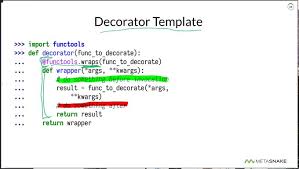What is Decorators in Python? How Decorators work.
Python decorators are a powerful tool in the arsenal of every Python programmer. They provide a way to modify or enhance the behavior of functions and classes without changing their source code. Decorators allow developers to add new features or functionality to existing code, making it more flexible, modular, and reusable.
In this blog post, we'll explore what decorators are, how they work, and how you can use them in your Python code.
What are Decorators?
Decorators are functions that take another function as input and return a new function as output. The new function can be used in place of the original function, with some additional behavior or functionality added to it. Decorators can be used to modify the behavior of a function without changing its source code, which makes them a powerful tool for code reuse and modular design.
Here's an example of a simple decorator:
Pythondef my_decorator(func):
def wrapper():
print("Before the function is called.")
func()
print("After the function is called.")
return wrapper
@my_decorator
def say_hello():
print("Hello!")
say_hello()
In this example, we define a decorator function called my_decorator that takes a function as input and returns a new function called wrapper. The wrapper function contains some additional behavior before and after the original function is called. We then apply the my_decorator decorator to the say_hello function using the @my_decorator syntax. When we call say_hello, it actually calls the wrapper function with the additional behavior added by the decorator.
How Decorators Work
To understand how decorators work, it's important to understand that functions in Python are first-class objects. This means that functions can be passed as arguments to other functions, returned as values from functions, and stored in variables. In other words, functions can be treated just like any other value in Python.
When a decorator is applied to a function, it takes the original function as input and returns a new function with the additional behavior added by the decorator. This new function can then be used in place of the original function, with the decorator's behavior applied automatically.
Decorating Classes
In addition to decorating functions, decorators can also be used to modify the behavior of classes. Here's an example:
Pythondef my_decorator(cls):
class Wrapper:
def __init__(self, *args, **kwargs):
self.wrapped = cls(*args, **kwargs)
def __getattr__(self, name):
return getattr(self.wrapped, name)
return Wrapper
@my_decorator
class MyClass:
def __init__(self, x, y):
self.x = x
self.y = y
def my_method(self):
print("My method was called.")
obj = MyClass(1, 2)
print(obj.x, obj.y)
obj.my_method()
In this example, we define a decorator function called my_decorator that takes a class as input and returns a new class called Wrapper. The Wrapper class contains a constructor that creates an instance of the original class and a __getattr__ method that delegates all attribute lookups to the wrapped instance. We then apply the my_decorator decorator to the MyClass class using the @my_decorator syntax. When we create an instance of MyClass, it actually creates an instance of the Wrapper class with the additional behavior added by the decorator.
Conclusion
Decorators are a powerful tool for Python programmers. They provide a way to modify or enhance the behavior of functions and classes without changing their source code. Decorators can be used to add new features or functionality to existing code, making it more flexible, modular, and reusable




Comments
Post a Comment